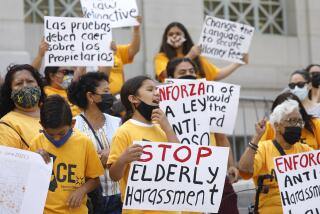Thousand Oaks Council Approves Anti-Slumlord Ordinance
THOUSAND OAKS — Despite concerns that the law might not be stringent enough, the City Council has embraced an anti-slumlord ordinance that subjects properties with previous health and safety problems to greater scrutiny.
After a 90-minute debate that stretched late into the night Tuesday, the council voted 4 to 1 to approve the ordinance, which targets scofflaw landlords who own several properties in the city. Councilwoman Elois Zeanah cast the only opposing vote, saying the law might sound appealing but would accomplish little.
Councilman Andy Fox, who initially proposed the ordinance a year ago, disagreed. “This program does represent a dramatic departure from the city’s past policy of reactive code enforcement,” he said. “It is going to be a significant enforcement tool.”
After confirming with the deputy city attorney that the law would affect few property owners, Zeanah said applying the existing laws more often would be a better answer than approving a new rule.
“This law does nothing,” Zeanah said before Tuesday’s meeting. “It’s a ploy to give someone a good election issue--that’s all it is.”
Councilwoman Linda Parks voted with the majority, but she also worried the new law might be little used. Both she and Zeanah suggested other ways to address substandard housing, but their suggestions were rejected on 3-2 votes.
The council acted only after hearing testimony from two sons of an elderly couple--Joy and Al Silver--who own the city’s most notorious problem property.
A year ago the Silvers received numerous citations involving an overcrowded squatters’ village near City Hall. The property has since been cleaned up, but smaller issues surfaced recently at a few of the couple’s other rental properties.
Discovery of the shantytown prompted the call for an anti-slumlord ordinance.
The Silver brothers, who contend that tenants’ unauthorized subleasing practices created the overcrowding problem, said they support the new law. But they asked the city to also help landlords who have run-ins with law-breaking tenants.
“I’d like to see a provision that helps with tenants who put landlords in a position of noncompliance,” said Todd Silver, who said many of his family’s difficulties stemmed from his father’s Alzheimer’s disease and the age of the rental houses.
After that request, Councilwoman Judy Lazar asked whether the city could offer more help to landlords. Deputy City Atty. Jim Friedl, who drafted the anti-slumlord ordinance, said code compliance officers attempt to help both landlords and tenants. But the parties tend to blame each other in many disputes over health and safety problems in housing, he said.
The new law, Friedl said, will put recalcitrant landlords under the “code compliance magnifying glass.”
Under the new law, any property owner who fails to correct violations after being cited twice in a year would be dubbed a “substandard housing owner.”
City code enforcement officers will then be free to check for violations at any property owned by that landlord, even without a complaint. Typically, code enforcers act only on complaints.
The new law does not increase punishments, which by state law cannot exceed a $1,000 fine and six months in jail for misdemeanor housing violations, and a $5,000 fine and a year in jail for repeat offenses.
Under council questioning, Friedl acknowledged that the law will probably not apply to many property owners because most landlords respond when cited for code violations.
But the law, Lazar said, will have a great deterrent value.
“We’re fortunate that we haven’t had more [substandard housing] situations, and we would like to avoid them,” Lazar said. “That’s the crux of the issue here.”
Also Tuesday, the City Council unanimously approved a six-month pilot program for proactive code enforcement, proposed by Lazar, to be used on a rotating basis in the city’s older neighborhoods.
The first areas scheduled to receive the added code enforcement beginning in June are the western portion of the Old Town neighborhood and an aging apartment complex at 850 Warwick Ave. Property owners and tenants will be notified before the effort begins.
Zeanah, who has pushed for citywide proactive enforcement since the late 1980s, prior to her election, seized on the issue.
“We do need to be proactive,” she argued. “I think we need to put this on a broader scale.”
Zeanah pitched a proposal to have Thousand Oaks city staff members look at how other cities actively pursue code violations and consider how to better work with landlords and tenants.
Mayor Mike Markey called Zeanah’s proposal “labor intensive, expensive and not logistically possible.”
“When you get into proactive code enforcement, you get into such minute details that you penalize the citizens for living.”
Zeanah was able to persuade only Parks to support her idea. The proposal was defeated on a 3-2 vote.
Parks offered another suggestion, also rebuffed on the same 3-2 vote. She suggested Thousand Oaks consider emulating San Jose, which processes code complaints itself rather than through the courts, and fines property owners $1,000 a day until the violation is corrected.
“I don’t really see how this [anti-slumlord law] is doing anything new,” Parks said. “We do have an opportunity, however, to do something substantial.”
More to Read
Sign up for Essential California
The most important California stories and recommendations in your inbox every morning.
You may occasionally receive promotional content from the Los Angeles Times.










